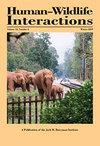Visual-Based Social Norms, Distance-Related Human–Wildlife Interactions, and Viewing Devices in Parks and Protected Areas
IF 0.9
4区 环境科学与生态学
Q4 BIODIVERSITY CONSERVATION
引用次数: 4
Abstract
Distance-related human–wildlife conflict presents a serious challenge in parks and protected areas across the world. Finding ways to alleviate distance-related human– wildlife conflict is hampered by both the difficulty of studying human–wildlife interactions in the field as well as the dearth of existing methodological tools. The purpose of this study is to investigate factors of group size, distance from bison (Bison bison), and use of wildlife viewing equipment on visitor proximity preferences in Yellowstone National Park (Wyoming, Montana, and Idaho, USA). Researchers collected data via intercept-surveys during summer 2015. The data were analyzed with repeated measures ANOVA to explore how these factors influenced acceptability ratings of distances between people and bison. Results indicate that people who always used a smartphone camera felt it was more acceptable to stand closer to bison than people who never used a smartphone camera. The discussion offers several practical applications for reducing human–bison conflicts as well as directions for future research.基于视觉的社会规范,与距离相关的人类与野生动物互动,以及公园和保护区的观看设备
与距离相关的人类与野生动物冲突给世界各地的公园和保护区带来了严峻的挑战。寻找缓解与距离相关的人类与野生动物冲突的方法受到研究人类与野生动物相互作用的困难以及现有方法工具的缺乏的阻碍。本研究的目的是探讨黄石国家公园(美国怀俄明州、蒙大拿州和爱达荷州)的群体规模、与野牛的距离和野生动物观赏设备的使用对游客接近偏好的影响。研究人员在2015年夏季通过拦截调查收集数据。对数据进行重复测量方差分析,探讨这些因素如何影响人与野牛之间距离的可接受度评级。结果表明,总是使用智能手机相机的人比从不使用智能手机相机的人更能接受站在离野牛更近的地方。讨论为减少人类与野牛之间的冲突提供了几个实际应用,以及未来的研究方向。
本文章由计算机程序翻译,如有差异,请以英文原文为准。
求助全文
约1分钟内获得全文
求助全文
来源期刊

Human–Wildlife Interactions
Environmental Science-Nature and Landscape Conservation
CiteScore
2.80
自引率
0.00%
发文量
0
审稿时长
11 weeks
期刊介绍:
Human–Wildlife Interactions (HWI) serves the professional needs of the wildlife biologist and manager in the arena of human–wildlife conflicts/interactions, wildlife damage management, and contemporary wildlife management. The intent of HWI is to publish original contributions on all aspects of contemporary wildlife management and human–wildlife interactions with an emphasis on scientific research and management case studies that identify and report innovative conservation strategies, technologies, tools, and partnerships that can enhance human–wildlife interactions by mitigating human–wildlife conflicts through direct and indirect management of wildlife and increased stakeholder engagement. Our intent is to promote a dialogue among wildlife professionals concerning contemporary management issues. As such, we hope to provide a repository for wildlife management science and case studies that document and share manager experiences and lessons learned.
 求助内容:
求助内容: 应助结果提醒方式:
应助结果提醒方式:


